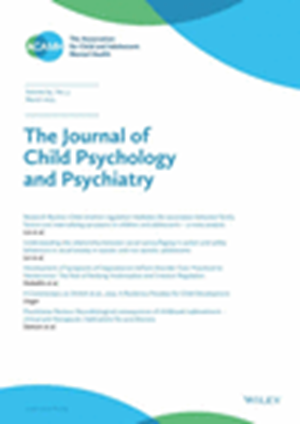学龄前自闭症男孩的社交技能:他们与父母的二元和三元互动的贡献。
IF 6.5
1区 医学
Q1 PSYCHIATRY
引用次数: 0
摘要
背景典型发育(TD)儿童在家庭环境中的互动与他们在学前阶段的社交能力有关,本研究的重点是男孩,研究的问题是自闭症儿童是否也是如此。本研究的一个具体重点是,男孩参与三位一体的母子互动的重要性要高于他们参与两位一体的亲子互动的重要性。方法通过治疗中心和社交媒体招募了 75 名学龄前自闭症男孩(月龄:男 = 49.45,女 = 11.03)及其父母。通过观察男孩与母亲和父亲(分别)的互动来评估他们的二元参与度,通过观察母亲与父亲和孩子的互动来评估他们的三元参与度。通过观察员和教师填写的 Q-sort,以及教师填写的社会反应性问卷(SRS),对男童在学龄前的社交能力进行了评估。结果在控制了男童症状的严重程度和智商后,他们的双向参与与同时观察员填写的 Q-sort 和教师报告的 SRS 测量结果相关,而他们的三向参与并不能解释这些测量结果的额外差异。在预测一年后的情况时,双向参与又与观察者 Q-sort 和教师 SRS 测量结果相关,而男孩的三向参与则能解释这些测量结果以及教师 Q-sort 的额外差异。结论学龄前自闭症男孩在与父母的二元和三元互动中表现出的参与性似乎可以转移到学龄前环境中,三元互动尤其重要。本文章由计算机程序翻译,如有差异,请以英文原文为准。
The social skills of autistic boys in preschool: the contributions of their dyadic and triadic interactions with their parents.
BACKGROUND
The interactions of typically developing (TD) children within the family context are associated with their social skills in preschool, and the question guiding this study, which focused on boys, was whether the same would be true for autistic children. A specific focus was on the importance of the boys' engagement in triadic, mother-father-child interactions over and above their engagement in dyadic, parent-child interactions. The boys' social skills were assessed concurrently with their family interactions and one year later.
METHODS
Seventy-five autistic preschooler boys (Age in months: M = 49.45, SD = 11.03) and both of their parents were recruited through treatment centers and social media. The boys' dyadic engagement was assessed from observations of their interactions with their mothers and fathers (separately), and their triadic engagement from an observation of mother-father-child interactions. The boys' social skills in preschool were assessed using a Q-sort completed by observers and teachers and by the Social Responsiveness Questionnaire (SRS) completed by teachers.
RESULTS
Controlling for the severity of the boys' symptoms and IQ, their dyadic engagement was associated with the concurrent observer Q-sort and teacher-reported SRS measures, and their triadic engagement did not explain additional variance in these measures. Predicting over one year, dyadic engagement was associated again with the observer Q-sort and teacher SRS measures, while the boys' triadic engagement accounted for additional variance in these measures as well as the teacher Q-sort. Finally, boys' dyadic engagement predicted gains in social skills on the observer Q-sort, and their triadic engagement was predictive of gains in the observer and teacher Q-sort.
CONCLUSIONS
The engagement that autistic preschool-age boys displayed in the context of their dyadic and triadic interactions with their parents appears to be transferred to the preschool setting, and triadic interactions are of particular significance.
求助全文
通过发布文献求助,成功后即可免费获取论文全文。
去求助
来源期刊
CiteScore
13.80
自引率
5.30%
发文量
169
审稿时长
1 months
期刊介绍:
The Journal of Child Psychology and Psychiatry (JCPP) is a highly regarded international publication that focuses on the fields of child and adolescent psychology and psychiatry. It is recognized for publishing top-tier, clinically relevant research across various disciplines related to these areas. JCPP has a broad global readership and covers a diverse range of topics, including:
Epidemiology: Studies on the prevalence and distribution of mental health issues in children and adolescents.
Diagnosis: Research on the identification and classification of childhood disorders.
Treatments: Psychotherapeutic and psychopharmacological interventions for child and adolescent mental health.
Behavior and Cognition: Studies on the behavioral and cognitive aspects of childhood disorders.
Neuroscience and Neurobiology: Research on the neural and biological underpinnings of child mental health.
Genetics: Genetic factors contributing to the development of childhood disorders.
JCPP serves as a platform for integrating empirical research, clinical studies, and high-quality reviews from diverse perspectives, theoretical viewpoints, and disciplines. This interdisciplinary approach is a key feature of the journal, as it fosters a comprehensive understanding of child and adolescent mental health.
The Journal of Child Psychology and Psychiatry is published 12 times a year and is affiliated with the Association for Child and Adolescent Mental Health (ACAMH), which supports the journal's mission to advance knowledge and practice in the field of child and adolescent mental health.

 求助内容:
求助内容: 应助结果提醒方式:
应助结果提醒方式:


